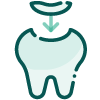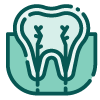We offer the at-home tooth whitening system. This involves wearing a custom-made tray containing whitening gel, for 10 to 14 nights. During your appointments the shade of your teeth will be recorded. As the shade will change gradually over the treatment, you can decide to stop treatment whenever you feel your teeth are bright enough. We ensure the solution is suitable for your teeth and gums prior to starting treatment.
Teeth Whitening

Teeth whitening is a safe and easy way to brighten the colour of your teeth. Cornelscourt Dental offer the at-home tooth whitening system. This involves wearing a custom-made tray containing whitening gel, for 10 to 14 nights. During your appointments the shade of your teeth will be recorded. As the shade will change gradually over the treatment, you can decide to stop treatment whenever you feel your teeth are bright enough. We ensure the solution is suitable for your teeth and gums prior to starting treatment.
How long should I wear the trays for?
This depends on the amount of lightening that you desire and the original shade of your teeth. It is very difficult if not impossible to accurately predict the outcome of bleaching a person’s teeth.
- If your teeth are relatively light to start with, the process will generally take a matter of a few weeks. Most teeth will do well after 14 to 20 sessions.
- If your teeth are quite dark or very yellow/grey or tetracycline stained it will take longer to bleach the teeth. The darker your teeth, the longer your teeth will take to get lighter. Severely tetracycline stained teeth, in extreme cases, can take 6 months or even up to one year to bleach.
- Younger teeth are easier to bleach due to greater porosity. The lighter the stain, the better the response. In order of increasing difficulty to bleach, these are the types of staining that most commonly occur:
Easiest to bleach: Yellow, Light grey, Light brown, Dark yellow, Dark brown
Most difficult to bleach: Grey or black
What are the side effects?
The side effects of teeth whitening are uncommon but do occasionally occur. They are usually transitory. They include minor gum ulceration, sore throat and tooth sensitivity. Generally these side effects resolve after one week.
What do I do if I have sensitivity?
Tooth sensitivity is the most common side effect of home bleaching. If you are experiencing more than a little sensitivity you should stop bleaching for a few days. You can then resume after 3-4 days. If teeth become ultra-sensitive you can place a sensitive toothpaste (e.g. sensodyne) into the bleaching trays and wear on your teeth for an hour a day. This usually works very well and you can recommence bleaching after 3-4 days. If you still experience problems, get in touch with us and we will help resolve this.
How will my teeth feel?
Normally the teeth feel very clean after bleaching. The bleaching materials also have an indirect effect on the gums in helping them to heal and improving the health of the gums. This is how the technique was invented as it was first used to heal gum irritation during orthodontic treatment.
How long does the bleaching last? Will I have to bleach my teeth again?
Normally the new whiter colour of your teeth keeps for several years. This will be influenced by what you eat, drink and smoke. Some patients need a top up after 3-4 years.
What foods/products stain a white smile?
The following are especially damaging:
- Foods like soy sauce, curry, red wine, coffee, and tea.
- Foods that are slightly acidic. These open up the pores of the tooth enamel, allowing stains to more easily move into your teeth.
- Tobacco. This is one of the biggest culprits in ruining white smiles.
- Extremely hot or cold liquids. These cause teeth to expand and contract, allowing stains to penetrate your teeth.
Does bleaching harm the teeth?
Safety studies show that bleaching teeth using a dentist prescribed home bleaching technique is safe for the teeth, the gums, and the other oral tissues.
Any questions?
We are experienced and sympathetic in dealing with each patient’s anxieties and pride ourselves on developing a personal relationship with our patients.















